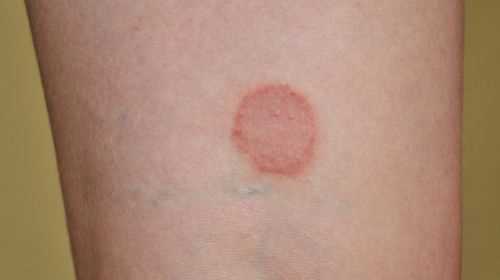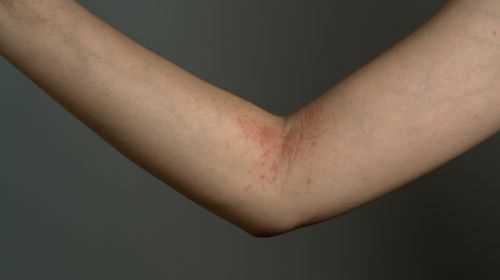Intertrigo (skin wolf) is a common diagnosis. Nevertheless, many do not know what is behind it. What is intertrigo? Which treatment is recommended? And are there any measures that reliably prevent the skin disease?
Itching and burning are typical of intertrigo; if left untreated, an infection can easily occur due to the damage to the skin barrier. How does contact dermatitis arise?
At a glance:
What is intertrigo?
An intertrigo (also intertriginous eczema, colloquially skin wolf) is by definition a superficial eczema that occurs preferentially in body folds (intertrigines). It is a form of contact dermatitis: friction, moisture and heat in combination lead to damage to the skin surface, which thus becomes a good breeding ground for bacteria and / or yeasts. Areas directly below the chest and buttocks, in the genital and groin region, on the inside of the thigh, in the buttock folds, abdominal folds, armpits or in the spaces between fingers or toes are often affected.
How widespread the skin disease is in the general population cannot be reliably determined. Women are affected more often than men. Because bed rest is a risk factor, it is estimated that around 20 percent of all over 80 year olds suffer from intertrigo.
How does an intertrigo develop?
Intertriginous eczema always starts with a simple skin irritation, which can have various causes, which often occur in combination, for example:
- Skin-to-skin friction
- abrasive clothing or diapers
- Moisture and / or heat build-up
- changes in the pH of the skin.
Accordingly, the following are considered to be special risk factors for intertrigo:
- poor personal hygiene
- excessive personal hygiene / grooming
- Care products that unbalance the pH of the skin
- a hot and humid climate
- heavy sweating
- Overweight / obesity (promotes the formation of skin folds)
- Endurance sports such as jogging or cycling (especially if the skin rubs against each other)
- Inappropriately cut clothing that rubs against the skin
- Clothing made from materials that do not wick away moisture (such as certain synthetic fibers)
- poorly ventilated shoes
- wearing diapers
- wearing prostheses
- Incontinence (can cause urine or stool buildup in the genital or anal area)
- a weakened immune system
- Diseases that weaken the skin barrier and delay wound healing (e.g. diabetes mellitus)
- Restricted mobility or being confined to bed (as certain skin areas are exposed to one-sided pressure).
Intertriginous eczema between the legs can also quickly develop in the summer when it is very hot, short pants or skirts encourage rubbing thighs.
If there is persistent moisture build-up on irritated skin, as is often the case in body folds or the navel, the top layer of skin (epidermis) swells and provides an optimal breeding ground for bacteria (e.g. staphylococci) and fungi (the yeast fungus Candida albicans is often here) . A corresponding infection intensifies the symptoms, so that pronounced eczema develops.
Symptoms: how can the intertrigo be recognized?
Intertrigo is characterized by symptoms that can also occur with other eczema, especially
- Redness,
- Overheat,
- Itch,
- Burning as well
- Oozing.
The transitions between intertriginous eczema and other inflammatory skin diseases (dermatitis) are fluid. The location of the affected skin area (body folds or other intertriginous areas) is usually used to delimit it.
If the damaged skin area becomes infected with fungi and / or bacteria, this can cause further symptoms and abnormalities, for example
- pains
- Increase in itching / burning
- Pustules and papules / nodules (especially around the edge of the inflammation focus)
- (oozing) blisters
- whitish deposits
- open, partly bleeding spots
- Cornifications / thickenings
- Crust formation
- sweet, putrid or otherwise unpleasant smells.
How is intertriginous eczema diagnosed?
The right place to go if you suspect intertrigo is a dermatological practice. The eczema is examined (visual diagnosis); if necessary, a small skin sample is taken in order to examine it microscopically and / or to be able to detect an infestation with fungi or bacteria using a cell culture. If the appearance and location of the dermatitis are characteristic, the diagnosis is intertrigo.
Treatment: measures for intertrigo
If the intertrigo is still in its early stages or if only a small area of skin is affected, there is a possibility that the irritation will subside after the cause has been eliminated (e.g. a change of clothes).
Larger, inflamed intertriginous skin areas should be kept as dry as possible, for example with the help of sterile wound compresses. Regular blow-drying, preferably with cold air, can also accelerate the healing of the eczema. If the affected part of the body is covered by clothing, the fabric should be breathable and washable at at least 60 degrees. Changing compresses and clothing frequently is important to reduce the risk of bacterial and / or fungal infection. Wound healing powders with zinc oxide absorb sweat / moisture and have an anti-inflammatory effect. Zinc creams and ointments also dry out the skin slightly and soothe itching.
If the eczema persists or even worsens despite the use of appropriate home remedies, medical advice should be obtained after seven days at the latest. If the affected skin area itches or burns, pustules, papules or blisters become visible or unpleasant smells can be detected, it is important to visit a dermatological practice as soon as possible. For treatment, disinfecting (antiseptic) and – if a fungal infection is detected – antifungal (antifungal) ointments or lotions are then prescribed. In more severe cases, cortisone creams can reduce inflammation. In order to prevent the formation of resistant bacteria, antibacterial (antibiotic) agents are usually not used today.
It is important to apply the prescribed creams, ointments or lotions exactly according to the instructions (thinly): A thick layer of cream keeps the inflamed skin areas moist, which can prevent healing. If several inflamed areas of the skin show an infection with fungi at the same time, depending on the severity, oral intake of an antimycotic may also be necessary.
Intertrigo: prognosis and course
At the beginning, an intertrigo is usually limited to a small, sharply defined reddening of the skin. In the course of the disease, inflammation and expansion of the affected skin area often occur. Fungal and / or bacterial infections are common. In severe cases, the top layer of skin (epidermis) may peel off, creating a large, open wound. In order to prevent a corresponding aggravation and / or chronification of the symptoms, larger skin eczema should always be treated professionally. Since open areas of the skin are a gateway for germs, chronic intertrigo can be dangerous, especially for elderly, immunocompromised or chronically ill people.
How long does it take to heal?
In general, intertrigo can be treated well. How long it takes for the eczema to heal completely depends on its size, the degree of inflammation and the general condition of the person affected. With intertrigo without infection, given appropriate medication, it takes about one to two weeks for the eczema to go away. If there is a fungal or bacterial infestation, therapy may be necessary for up to four weeks.
Prophylaxis: How can intertrigo be prevented?
Various measures contribute to the prevention of intertriginous eczema:
Let air into your skin whenever possible
Pay attention to comfortable, loosely fitting clothing cuts that do not rub against the skin
Wear breathable underwear and clothing (for example made of natural fibers such as linen or cotton)
use special, moisture-wicking functional underwear / bras and clothing when doing sports
wear breathable, well-ventilated and comfortable shoes
Always shower after strenuous activity
Always dry the entire body thoroughly after bathing, swimming or showering down to every skin fold / space between the toes, and if necessary blow dry as well
Avoid being overweight or, if necessary, reduce body weight in order to prevent skin wrinkles
Pad easily irritable parts of the body with hollow inserts during exercise and reduce skin-to-skin friction (for example on the inner thighs) by applying fatty creams such as petroleum jelly
in bedridden people, change the lying position frequently to avoid bedsores
In the case of chronic diseases such as diabetes mellitus, take care of the correct care, go to foot care regularly.
In principle, the onset of skin irritation should be treated consistently and if the symptoms persist, it should be clarified quickly by a medical doctor so that no intertrigo occurs.
.


